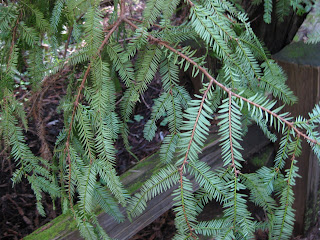
Delicate foliage of the Coastal Redwoods is almost lacy in appearance, with narrow, sharp-pointed needles growing one-half to three-quarters of an inch long. Cones from these giants are only about an inch long with 14 to 24 seeds. Redwood seedlings grow rapidly, more than a foot a year in good conditions.
In 1936 this magnificent grove was opened to the public as Armstrong Redwoods State Park. In 1964 the grove’s status was changed to a State Reserve.
Sense the quiet as you walk trails through these giant trees, small streams, and tiny patches of sunlight.

As you can see, this tree is 1300 years old. Coastal Redwoods can live more than 2000 years. The high tannin content of the wood gives the trees remarkable resistance to fungus diseases and insect infestations. Their thick fibrous bark insulates them even more from forest fires.


A natural Coastal Redwood forest is a perfect recycling system. The soil contains few nutrients; most of the substance necessary for life is in the trees themselves, living and dead. If trees are removed from the forest instead of being allowed to die and decay naturally, many nutrients are lost from the cycle.
More photos later. It’s so hard to capture their magnificence, size, and presence. And you feel so insignificant.


